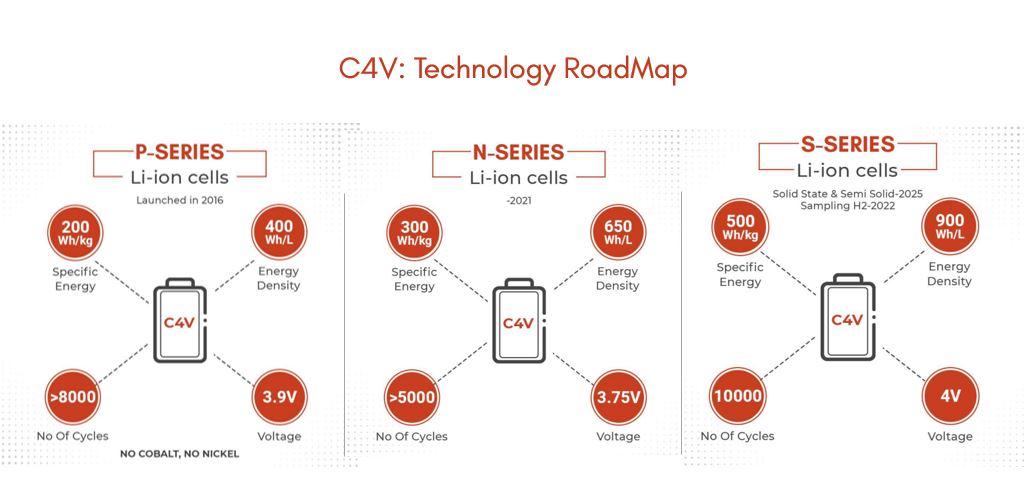
To transcend current expectations for performance
metrics demanded of high-energy-power and long calendar
life lithium-ion batteries, the physicochemical
requirements of the end-use application must coalesce
with the knowledge to create the proper chemistry and
the expertise to properly manufacture cost effectively
at scale. C4V embodies this synergy.
Approximately 80% of the cost to produce lithium ion
cells originates from four major components: the anode,
cathode, separator, and electrolyte. C4V has discovered,
patented, and commercially developed processing
technology for next generation anode and cathode
materials, while working jointly to optimize these
materials with current industry giants in the
electrolyte and separator space. C4V has also quantified
and qualified more than 15 other component that go along
with four key components mentioned above in a lithium
ion battery cell. In addition, designing cells for
different applications in cylindrical, pouch and
prismatic form factors is integral part of C4V’s
development process.
P-Series
P-Series batteries, commercially implementable in 2019, will feature a
cobalt and nickel-free cathode chemistry that boasts the highest voltage
and
cycle lifetime of any currently commercial material. In addition,
compositionally-patented modifications at the crystal-level ensure,
beyond
an increased energy density and high-rate capability, unrivaled safety
in
the event of thermal runaway or fire exposure.
C4V anodes will contain graphite produced from in-house processing
technologies blended with its composite silicon. Overwhelmingly used in
current anodes, graphite often requires expensive thermal and
environmentally toxic chemical treatments to raise purities above 99.95%
for
approved use. C4V’s proprietary processing technology for purification
and
spheronization has eliminated the need for either step, while
drastically
reducing energy consumption via modification of commercially-ready
equipment
that can achieve yields of greater than 70%. Majority of current
commercial
technologies can only achieve around 40% yield with processing
techniques
that are more than 20 years hold. Proven control over morphology,
surface
area, and particle size distributions ensures that its integration with
composite silicon meets desired performance metrics.
C4V’s composite silicon, a game-changer for improved volumetric capacity
and
energy density, boasts a similarly cheap, scalable, and
environmentally-friendly manufacturing process. Silicon has long been
desired for use in the anode given a specific energy capacity of > 3000
mAh/g. However, unsuccessful efforts to tame the drastic volume
expansion
experienced during lithiation have tempered commercial viability. C4V’s
composite silicon technology prevents catastrophic volume expansion via
nano-structuring. By allowing the primary particles to expand internally
and
not crack, structural integrity is maintained and improved performance
is
achieved.
P-Series batteries will demonstrate energy densities and volumetric
capacities of 200Wh/kg and 500Wh/L. Currently, design and optimization
efforts have focused on cylindrical and prismatic cells with 2170 and
3270
variants with improved heat dissipation slated for production. With the
support of strategic partners and a key acquisition of cell
manufacturing
equipment, production at a nominal 1 GWhs scale will commence during the
second half of 2022.
N-Series
N-Series Battery improvements will focus upon optimizing anode and cathode formulations and introducing a more thermally-stable electrolyte to enhance performance.
While the anode and cathode materials determine the theoretical limits for a battery’s storage capacity, the electrolyte, serving as an interfacial lithium transport medium for either electrode, determines the power density, imparts electrochemical stability within the cell via passivation of both anode and cathode surface layers, and to a large degree dictates a battery’s chemical response to non-equilibrium conditions like overheating which can lead to fires.
Being rather sensitive to environmental temperatures, current commercial electrolytes limit the use of lithium-ion cells to narrow temperature ranges, requiring the use of an electronic battery management system and other forms of insulation to maintain thermal conditions optimal for cycle life and performance.
C4V has identified and is working with an electrolyte that would lower the maintenance requirement for keeping the batteries cool. So far, this electrolyte has demonstrated stability up to 65C. Implementation for volume manufacturing is expected by 2021 with concurrent improvements in energy density and volumetric capacity to 300Wh/kg and 650Wh/L, respectively.
S-Series
We strive to continue working towards better, cheaper, and safer battery
technologies and processing techniques in the coming years.
A significant part of this commitment involves developing a solid-state
battery. While theoretically possible now, no clear projections or
blueprints for bringing solid state batteries into the market exist,
currently. It may take another 20 years to fully commercialize and have
a
stable manufacturing and supply chain infrastructure for this
technology.
But at C4V, we are taking a different and more practical approach to
overcome some of these challenges. We have been able to replace more
than
50% of the liquid electrolyte with a Solid State electrolyte to produce
semi-solid-state technology that would include advantages of both the
systems.
Additionally, our initial tests from S-series batteries demonstrate
energy
densities and volumetric capacities of 400Wh/kg and 800 Wh/L. We
confidently
project these unique batteries will be ready for volume manufacturing by
2025 along with a stable supply chain.
